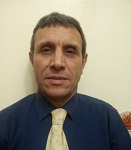
Plenary Lecture
The Use of the Inverse of the Belonging Probability Technique in Detection

Professor Benabdellah Yagoubi
Laboratory of Signals and Systems
Department of Electrical Engineering
University of Mostaganem
Algeria
E-mail: yagoubibenabdellah@yahoo.com
Abstract: Faults or perturbations detection is becoming crucial field in control and supervision. Early detection of tumors, ulcers and so on, in biomedical imagery, is vital for the medical diagnosis. The earth ecosystem is being affected by forest fires, volcanic eruptions and many other related fields, their early detections are very important to make necessary predictions. In engineering applications, various supervision and control methods for detecting new surges in processes describing phenomena such as those previously mentioned, focus on direct observation of measurable variables with respect to a certain threshold value of the process. Various changes in the random process could hence be detected, but only if these faults had a considerable impact on the observed variables. So, despite the good results obtained using these techniques, they are, however, unable to magnify the data that are associated only to the fault or perturbation in a given random signal. We will discuss, therefore in this speech, a simple technique based on the inverse of the belonging probability (IBP) of a rare event, representing the fault or the new change such as an early tumor, to belong to an initial Gaussian white noise realization representing a normal working state signal model (before changes). We will show, in addition, in this lecture that this technique is capable of magnifying the zone of interest, such as a fault in a machine or a starting fire in a forest, leading to accurate and a clear fault detection or any surge in a random process. The inverse of the belonging probability technique is extremely important for the fault detection and monitoring a random process, and can be, thus, very useful for supporting a direct observation of a real random signal.
Brief Biography of the Speaker: Dr B. Yagoubi received the M. Sc degree in Electrical Engineering in 1985 from Bel-Abbes University, Algeria and the Ph. D degree (amorphous thin films) (1986-1989) in the Faculty of Sciences from Brunel University (UK). He was the head of the Signals and Systems Laboratory (1999-2003) and the head of the Department of Electrical Engineering (2005-2006). He is lecturing the theory of digital signal, systems modeling and identification, random processes and detection (1996-2016) at Mostaganem University, Algeria. He has been involved in some national projects such as forest fire detection, heart rate variability in the LF and HF bands to characterize the autonomous nervous system, and study and application of random processes. Currently, he is focusing on extracting useful information from mono-dimensional and multidimensional signals as well as on detection using the inverse of the belonging probability technique of a rare event to a Gaussian realization, as part of a national project. Further research interests are in real signals and models geometric representation based on Gram-Schmidt orthogonalization concept, as well as using a relative geometric space of observation.